In 2016, it was estimated that the number of books sold in one year stands at around 2.2 billion copies. Over 72% of this figure is attributed to the US, China, and the UK. Currently, Google’s estimates are that there are around 129,864,880 published books in the world at this moment.
The global book publishing industry, including both the trade and educational segments, is projected to rise by 1.9% annually by 2030. However, unexpected circumstances like the global pandemic could heavily influence the market for better or worse:
- As of 2023, the global book publishing revenue stands at $129 billion, jumping from $122 billion in 2018.
- The global book publishing market will be valued at $143.65 billion in 2023 and is expected to grow to $163.89 billion by 2030.
Global book sales
Regarding global book sales, trade books are the market’s biggest segment, accounting for more than 60% of global revenue. However, the trade segment has seen some stagnation over the last several years:
- In 2023, the trade book segment is projected to reach $78 billion globally; by 2027, the revenue will increase to $82.7 billion.
- This figure, however, will still be lower than pre-pandemic levels. Considering the global book revenue growth, it is clear that the trade book segment won’t be the driving force behind this growth.
- In terms of format, print books still dominate the market with ~77% of the share but are expected to stagnate, while audiobooks will grow by 27% over the next 5 years.
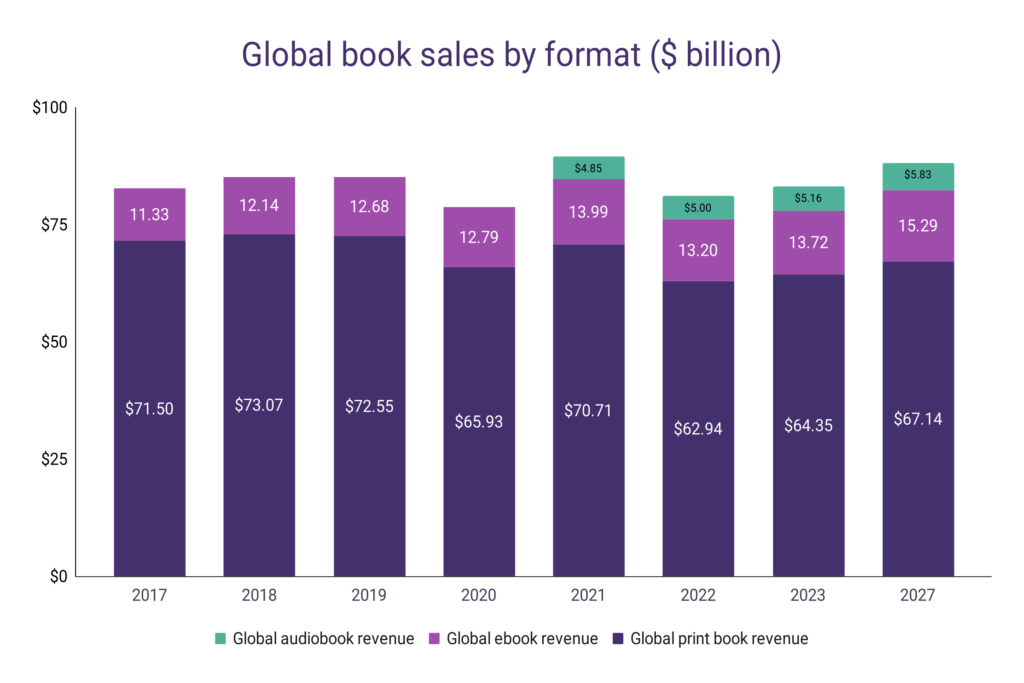
- Since 2019, India has surpassed the UK as the world’s 5th largest book market. Today, the big 5 in the global book market are the US, China, Japan, Germany, and India.
- By 2027, the US will account for a quarter of the global book revenue, and the top 5 book markets will account for over 68% of the global book sales revenue.
The US is also one of the biggest markets for Wordle, where it was purchased by the newspaper of record — The New York Times. Millions of people attempt to solve Wordle every day.
Book sales by category
As of 2022, over 788 million copies of print books are sold in the US in one year. While this figure presents a drop from a record-breaking 2021, print book sales are still well over pre-pandemic levels.
Since 2021, fiction books have become the dominant trade book category, overthrowing nonfiction books. However, adult nonfiction is still the best-selling category among trade books, accounting for over 37.8% of total print book sales in the US.
- From 788 million copies of print books sold in 2022, over 404 million were fiction books, and 360 million were nonfiction books.
- Over 52.9% of all print book sales in the US in 2022 were in the fiction category.
- Fiction books generated over $10 billion in trade revenue in 2021, accounting for 53.4% of all trade book revenue in the US.
- Nonfiction books generated $7.34 billion in 2021.

In terms of the age categories, adult nonfiction still dominates the market, but the young adult segment is the one that’s recording the fastest growth:
- Over 37.8% of all books sold in the US come from the adult nonfiction segment. However, in 2018 this share was over 43%.
- Adult fiction (24.7%) and children’s fiction (24.1%) are behind but trending upward over the last several years.
- However, the YA segment is recording the biggest growth while still small in size. Since 2018, the share of YA book sales in total print sales has increased by over 34%.
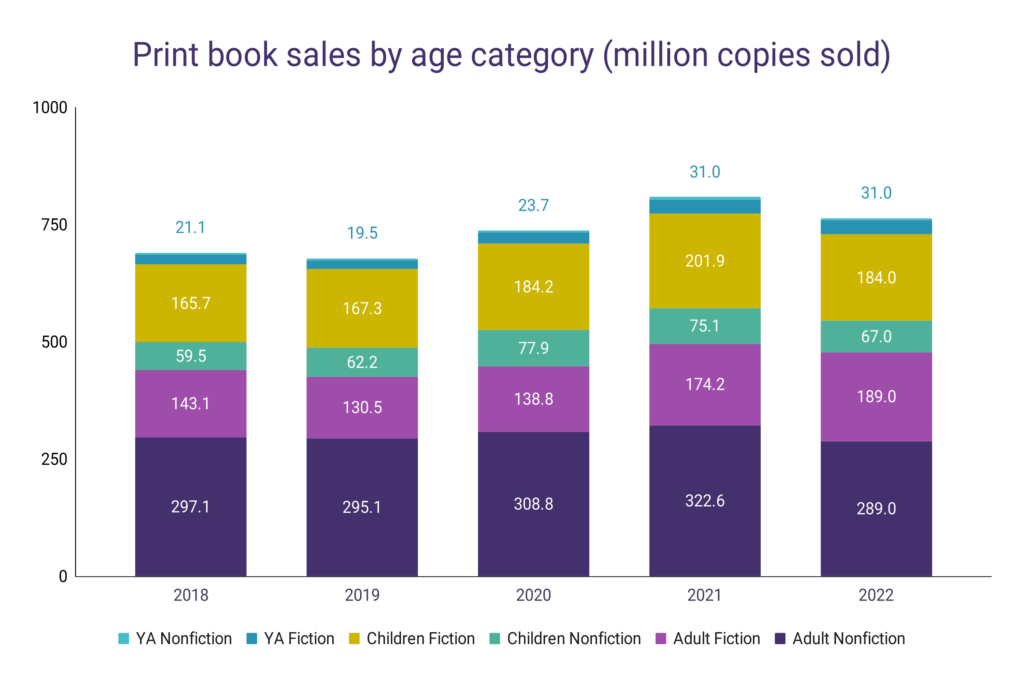
Poetry has gained some popularity over the last few years but is way below the numbers from the beginning of the 21st century.
- Around 10,100 poetry books are published every year in the US.
- From 2013 to 2017, poetry was the fastest-growing category in terms of sales.
- Around 3 million copies of poetry books are sold every year.
- 11.7% of US citizens read poetry at least once a year, dropping from 17% in 1992. Women (14.5%) read poetry more than men (8.7%).
- The rise of Instapoetry emerged as the dominant source of the category’s popularity and sales.

Over $705.1 million every year is spent on religious books in the United States, which sell more than 179 million copies. The religious book market is valued at $1.42 billion and has increased by 22% since 2020.
As the most popular religious book of all time and the best-selling book overall, the Bible sells over 20 million copies every year, generating over $430 million in revenue.
Book sales by format
In the trade book segment, physical books are still dominating the market. However, digital sales are on the rise, especially audiobooks, and will be the driving force behind book sales growth over the next several years.
- In 2022, the total revenue from the trade book segment was $17.36 billion.
- 78.80% of that revenue came from print books, while digital sales accounted for 21.19% of the revenue.
- Over the last 5 years, audiobooks have been the fastest-growing format in the book market, as the revenue from audiobooks increased by 53.39% since 2018.
- e-books had a great 2020, mostly attributed to the pandemic, but they’re in the overall decline over the last 5 years.
| Format | Total revenue ($ billion) | e-books | Audiobooks | |
| 2922 | $17.36 | $13.68 | $1.87 | $1.81 |
| 2021 | $18.79 | $15.02 | $1.97 | $1.80 |
| 2020 | $16.84 | $13.15 | $2.07 | $1.62 |
| 2019 | $15.87 | $12.57 | $1.85 | $1.45 |
| 2018 | $16.16 | $12.91 | $2.00 | $1.25 |
| 2017 | $15.95 | $12.87 | $2.05 | $1.03 |
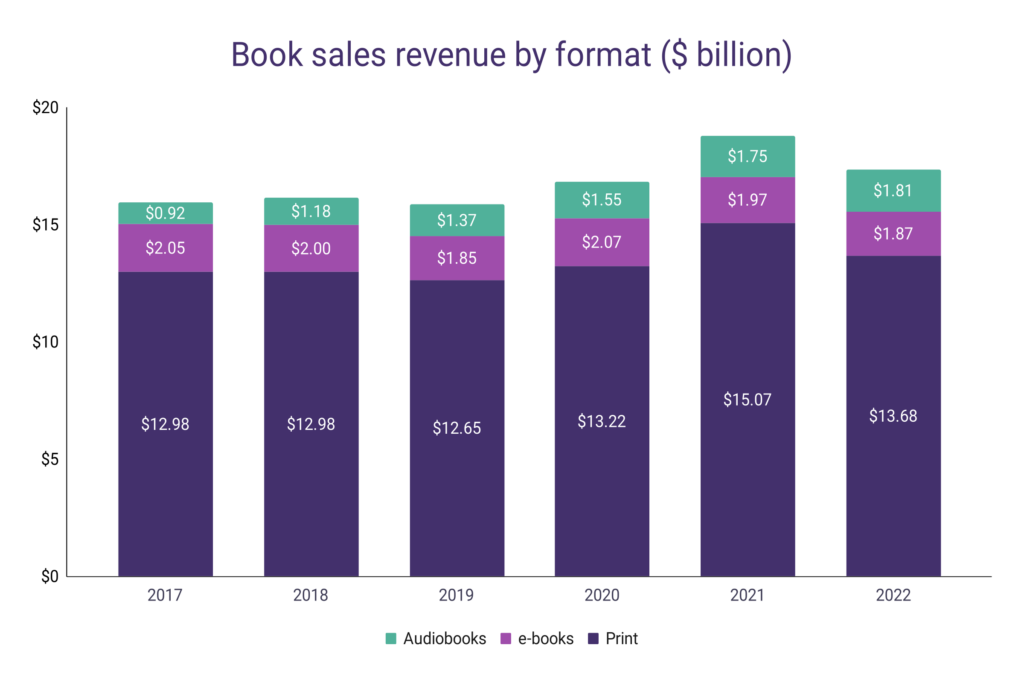
- Over the last 5 years, total revenues from trade books grew by 7.43%, with audiobooks having the biggest contribution to the growth:
- Revenue from print books has grown by 5.39% since 2018, e-book revenue has declined by 6.5%, while audiobook revenue has grown by 53.39%.
- Over the 5-year period, the share of print books in trade revenue dropped by 1.89%, e-book revenue share dropped by almost 13%, and audiobook revenue share jumped by 42.79%.
| Format | Print books | e-books | Audiobooks |
| 2022 | 78.80% | 10.77% | 10.43% |
| 2021 | 80.20% | 10.48% | 9.31% |
| 2020 | 78.50% | 12.29% | 9.20% |
| 2019 | 79.71% | 11.66% | 8.63% |
| 2018 | 80.32% | 12.38% | 7.30% |
| 2017 | 81.38% | 12.85% | 5.77% |
| 5-year growth | -1.89% | -12.96% | 42.79% |
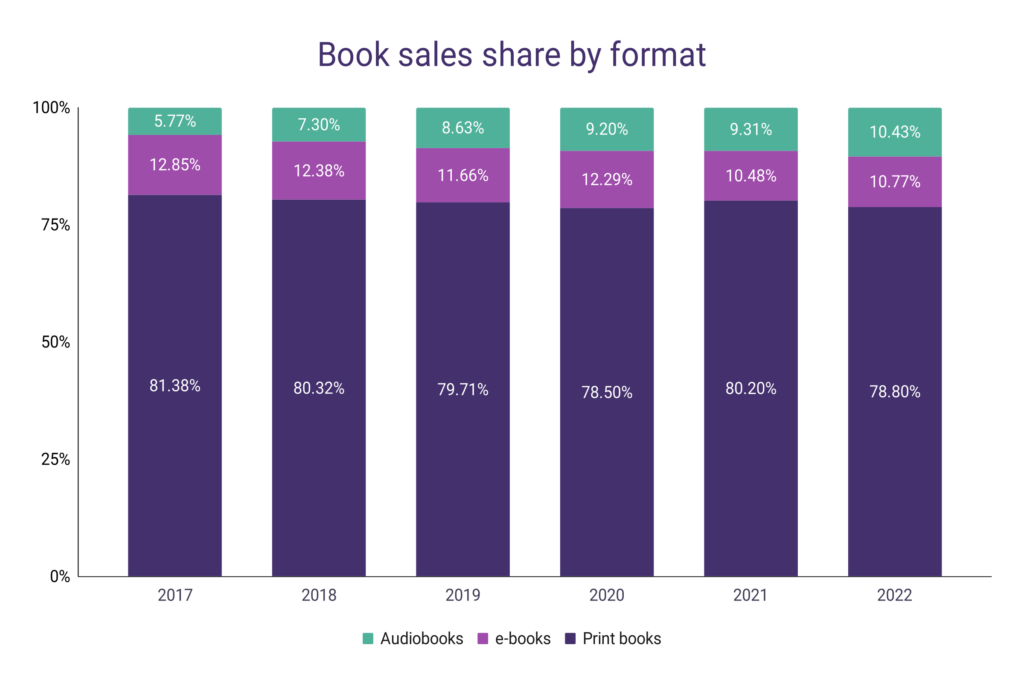
Online book sales
Since 2017, the majority of book sales in the United States have occurred online. While this distribution channel has been growing consistently, the pandemic accelerated this growth and made online book sales a dominant book-purchasing channel:
- Over 18$ billion of annual book sales in the US are made online as of 2020.
- During 2020, the first pandemic year, online book sales were 24% higher compared to 2019, making online book sales grow at a 4-year rate over 12 months.
- Over the last 9 years, the revenue from online book sales has doubled, with an average annual growth of over 8%.
- As of 2020, online book sales account for over 71.2% of all book sales in the United States, including both trade and educational segments.
- 2017 was the first year online book sales outperformed physical sales, and this distribution channel has remained dominant on the market ever since.
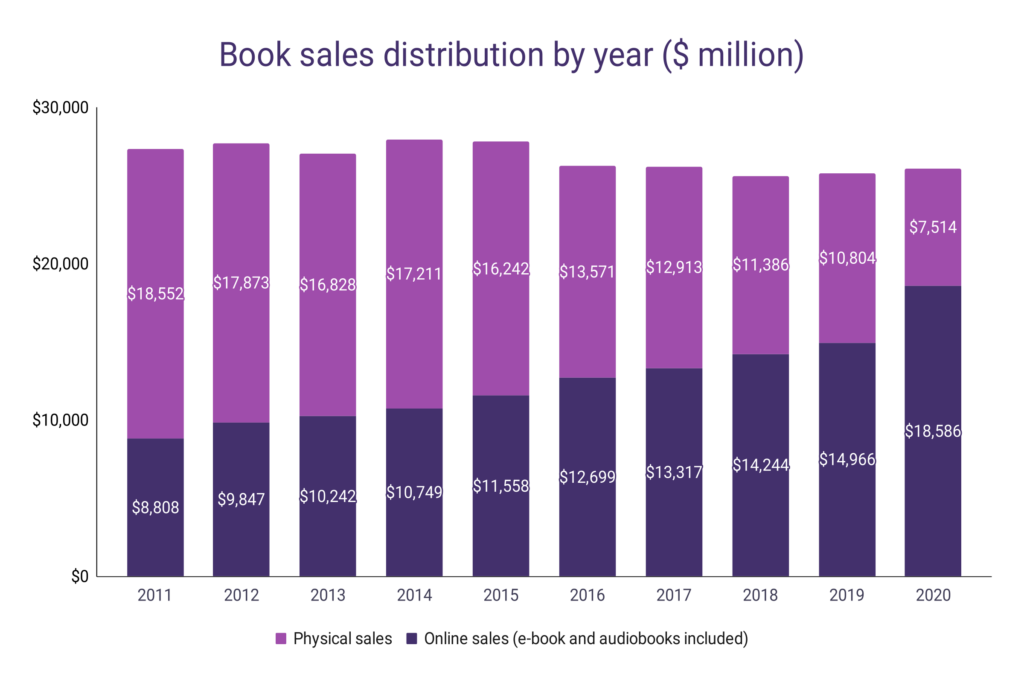
Impact of Covid on book sales
Unlike many other industries, which suffered the severe consequences of the continuous lockdowns and the overall shift in consumer behavior, book sales survived and even thrived during the Covid-19 pandemic.
Of course, not all segments in book sales had the same fate during 2020 and 2021, as physical bookstores had a tough time coping with the lack of visitors while online sales soared:
- During 2020, book sales in the United States increased by 9.27% compared to 2019.
- Additionally, in 2021 sales increased by 11.23% compared to 2020.
- This means that over the two pandemic years, book sales in the US jumped by 21.5% over 2019.
- The driving force behind this growth was fiction, for which the unit sales grew 9.6% in 2020 over 2019 and then by 17.1% in 2021 over 2020.
- However, all major categories recorded sales growth during the pandemic as well.
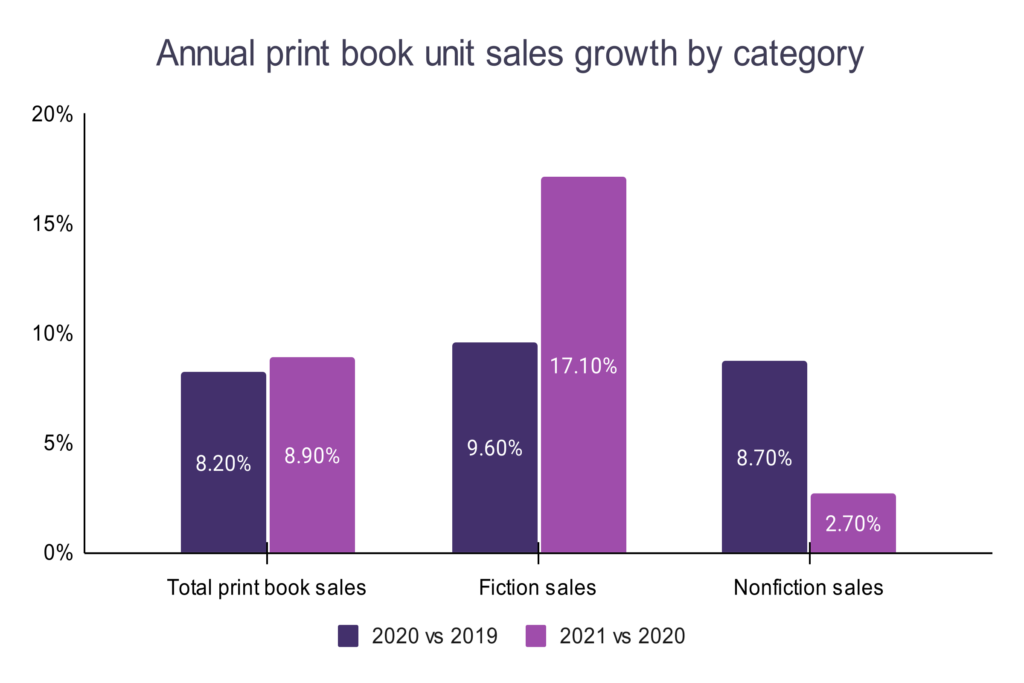
- Revenue of the US bookstores in 2020 dropped by 31% over 2019, from $8.9 billion to $6.16 billion.
- Even with the rebound year in 2021, bookstore sales were still below the pre-pandemic levels.
- During April 2020, bookstore revenue was 73% lower compared to the same month in 2019, while May sales were down by 62% compared to May 2019.
| Year | January | February | March | April | May | June | July | August | September | October | November | December |
| 2019 | $1,005 | $574 | $592 | $639 | $684 | $603 | $580 | $1,103 | $852 | $633 | $623 | $1,043 |
| 2020 | $957 | $569 | $388 | $168 | $259 | $366 | $412 | $725 | $583 | $427 | $465 | $844 |
| 2021 | $769 | $430 | $513 | $481 | $592 | $659 | $668 | $1,082 | $829 | $655 | $665 | $1,127 |
Holiday book sales
Holiday season is widely considered as the shopping season, and this applies to almost every possible retail category. Books are not an exception to this rule, and some of the highest-selling figures during the year are usually recorded from the last week of November until the year’s end:
- Some estimates show that 1 in 4 books are sold during the holiday season.
- Christmas sales are the biggest contributor to this trend, as almost 12% of all books sold during the year are sold around Christmas.
- Black Friday month regularly outsells October, as November sales are usually 15% higher compared to the previous month.
- Over 82% of all books sold during November are print books, higher than the annual average.
- Over the last 5 years, book sales revenue for December has constantly been over $1 billion.
- November and December sales account for over 21% of the annual revenue of US bookstores.
Used book sales
While this segment of book sales doesn’t occupy the attention of the media, the second-hand book market is not to be underestimated. In fact, global used book sales are growing at a faster pace than new books, and the projections are that things will remain this way over the next decade:
- The global market for second-hand books stands at $24.03 billion as of 2022, growing by 5.5% since 2021.
- It is estimated that the used book market will grow to over $45 billion over the next 10 years.
- The used book market accounts for 15% of the global book market as of 2020.
- Over 50% of all used book sales occur in the US and Europe.
- Over 70% of students choose to buy a used book over the newly-published one.
Self-published book sales
While it is estimated that around 1 million books are sold every year in the United States, this figure doesn’t take into account the largest segment of the publishing industry – self-published books.
While there are many controversies around Amazon’s impact on the publishing industry, one thing remains certain – it revolutionized self-publishing and enabled millions of authors to compete in the book market:
- It is estimated that over 300 million self-published books are sold every year.
- Also, 1 in 3 ebooks sold in the United States is self-published.
- On the other hand, self-publishing authors who decide to compete in the audiobook market are facing harder competition, as over 99% of all audiobooks sold on Audible as self-published.
- Depending on the conditions, self-published authors can earn as much as 70% of royalties for every book sold.
However, it’s hard to compete in the book market and promote the title. Most of the self-published books rarely get the attention of the readers, and this reflects sales and revenue figures:
- Over 90% of self-published books sell under 100 copies during their lifetime.
- The average self-published author will earn under $1,000 from book sales during the year.
- The average self-published title will sell around 250 copies during its lifetime.
| Year | Self-published print books: Amazon | Self-published print books: Total | Share of self-published print books: Amazon |
| 2007 | 3,804 | 66,732 | 5.70% |
| 2008 | 11,498 | 77,132 | 14.90% |
| 2009 | 25,212 | 96,724 | 26.10% |
| 2010 | 35,686 | 114,108 | 31.30% |
| 2011 | 58,857 | 158,674 | 37.10% |
| 2012 | 131,456 | 234,931 | 56.00% |
| 2013 | 187,864 | 305,160 | 61.60% |
| 2014 | 293,436 | 429,240 | 68.40% |
| 2015 | 425,752 | 577,213 | 73.80% |
| 2016 | 517,705 | 657,062 | 78.80% |
| 2017 | 929,290 | 1,060,821 | 87.60% |
| 2018 | 1,416,384 | 1,547,341 | 91.50% |
Amazon book sales
Amazon became the biggest book-selling company in the world, and it’s taking over the market by storm. Every year, Amazon’s share in the global book sale increases, and today it is estimated that the company controls the majority of the book market:
- Amazon’s book-selling revenue in a year stands at $28 billion globally. This makes the company accounting for over 30% of the global trade book sales.
- In the United States, the company reportedly controls over 40% of all print book sales.
- However, some estimates suggest that in 3 years, the company will control over 70% of the US book market.
- In the e-book segment, Amazon is accounting for over 80% of all e-books sold in the US.
- In addition to that, the company dominates the self-publishing market, as previously discussed.


